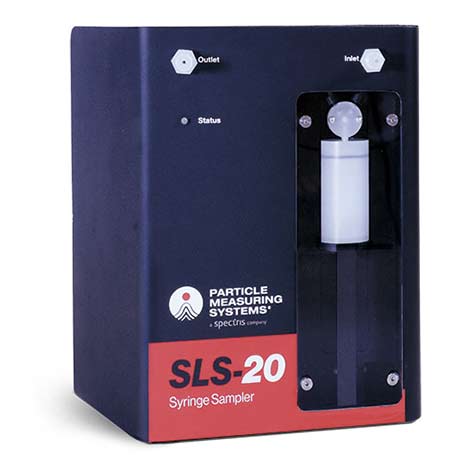Welcome to the world of liquid particle counting and syringe sampling…
If you’re new to liquid particle counting, you might not know anything about how we know if liquids are clean. One method to determine a liquid’s cleanliness is syringe sampling.
 Intro
Intro
A syringe sampler represents the simplest delivery system for precisely delivering a sample to the particle counter. The precise motion of the syringe pump produces a steady flow of fluid that is free of pulsations that are typical of most pumps suitable for chemical delivery. Additionally, the elimination of any valves or complex sample plumbing ensures rapid cleanup between samples. Care must be exercised when bubble formation is a concern; however, proper sample handling can usually overcome these issues. Syringe sampling is a valuable and low-cost tool to use for testing particle levels in fluids.
The Sample Liquid
When particle measurements from an unpressurized source are required, a method for delivering the fluid to the particle counter must be selected. The choices available depend on the fluid that must be sampled. Water samples provide the greatest range of options, while fluorinated chemistries such as HF can restrict the choices significantly. Determining the best solution requires consideration of the compatibility of the wetted surfaces with the fluids that must be sampled. Additional consideration should be given to the possible combinations that can be created in the plumbing and pump cavity when switching from one chemistry to another.
Liquid Flow
Unlike peristaltic and diaphragm pumps, the syringe pump draws the fluid through the particle counter in a smooth, continuous flow. Pulsations in flow that are typical with peristaltic and diaphragm pumps represent the increase and decrease in fluid velocity and this change will affect the instrument resolution.
Remember, resolution is the ability of the particle counter to discern size difference between two particles close to each other in size.
Gear pumps, while offering steady constant flow, can be limited in use due to fluid compatibility with the wetted components. Another consideration for the sampler is the volume of sample available. Many particle counting applications only have a limited volume, yet making several measurements is desired for demonstrating sample accuracy. The ability of a syringe sampler to precisely measure volumes < 1 ml is very advantageous in this situation.
Additionally, the syringe sampler has the ability to delay initially while the flow ramps to speed and stabilizes at the particle counter’s calibrated flow rate. This delay is often called the tare volume in particle counting applications. Coordinating such a delay in other pumping solutions could be difficult and costly to implement.
Maintenance
Unlike a compression sampler, which pushes the fluid through the particle counter, there are no valves or volume measurement containers in front of the particle counter. Keep this in mind:
- The additional plumbing associated with these types of samplers must be cleared of particles between every sample. This can potentially increase the time and chemical volume required to complete a series of samples. Since the syringe sampler draws the sample through under a vacuum, the plumbing that exists between the sample fluid and the particle counter is limited to the tubing connected to the sampler inlet.
- Cleanup between tests, purging the system of the previous sample, and other maintenance tasks will require fewer samples, which translates to less fluid waste.
The multiple benefits of flow and volume accuracy, smooth continuous fluid motion, small volume capability, and coordination of particle counting with sample flow enables the syringe sampler to provide many attractive advantages for fluid delivery to a particle counter.
Check out syringe sampler systems from PMS…
- Syringe Liquid Particle Sampler: SLS-20 for Chem 20 Batch Sampling
- Liquid Particle Counter for USP 788 – APSS-2000
- Syringe Liquid Particle Sampler: SLS
Leran more… Save this application note to read later here.
